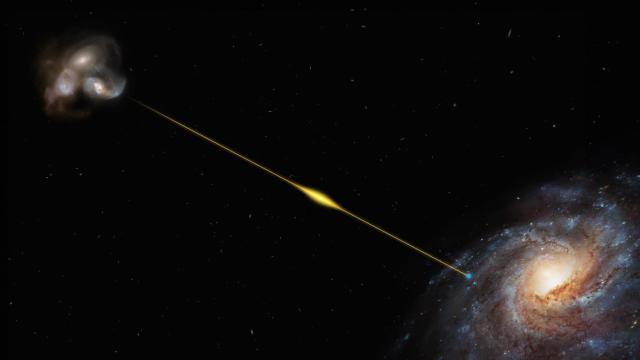In June 2022, a radio telescope in Western Australia detected a fleeting radio signal from a galaxy over 10 billion light-years from Earth. Now, a team of astronomers that studied the blast have confirmed it’s the most distant of its kind yet seen.
The radio signal was a fast radio burst, or FRB, a type of short electromagnetic outburst far more energetic than our Sun. The FRB was spotted by CSIRO’s Australian Square Kilometer Array Pathfinder (ASKAP), a radio telescope composed of three dozen 40-foot (12-meter) dishes, and follow-up observations of the burst were taken using the European Southern Observatory’s Very Large Telescope in Chile. Analysis of the burst’s origins in the sky and its energy was published today in Science.
“Using ASKAP’s array of dishes, we were able to determine precisely where the burst came from,” said Stuart Ryder, an astronomer from Macquarie University and the study’s co-lead author, in an ESO release. The follow-up observations revealed that the burst was “older and further away than any other FRB source found to date and likely within a small group of merging galaxies,” Ryder added.
The team located the FRB’s source: a galaxy system at a redshift of about 1, which corresponds to a source over 10.147 billion light-years away, according to the Las Cumbres Observatory. According to the ESO release, the recent burst—dubbed FRB 20220610A—emitted about 30 years’ worth of the Sun’s energy in a fraction of a second. Though the origins of fast radio bursts remain mysterious, compact, dynamic objects like neutron stars and their even-more-extreme version, magnetars—are leading candidates.
Distant fast radio bursts like FRB 20220610A are useful to astronomers because they reveal gas that sits between galaxies. This ionized gas contributes to the overall mass of the universe, but some of that mass is difficult to detect because it is very spread out in the spaces between galaxies, according to study co-author Ryan Shannon, an astronomer at the Swinburne University of Technology in Australia, in the same release.
The farther away a fast radio burst is, the more of that diffuse gas it reveals across the universe—a principle called the Macquart relation. Some recent fast radio bursts appeared to break this relationship,” Ryder said. “Our measurements confirm the Macquart relation holds out to beyond half the known universe.”
ASKAP has a history of spotting mysterious radio bursts, even from within our own galaxy. In 2021, a team of astronomers used the radio array to spot a curious radio signal corkscrewing towards Earth from near the galactic centre. The telescope also images other structures; last month, astronomers described evidence for two polar ring galaxies in the telescope’s WALLABY survey data.
Though ASKAP is a useful set of eyes on the radio universe, it’s just the precursor of what’s to come: the Square Kilometer Array (SKA) Observatory, which will primarily image the universe’s enigmatic Epoch of Reionization using thousands of radio dishes around the world.
Construction on the SKA began late last year and the observatory is expected to be operational by 2028. But astronomical projects abhor a timeline, so don’t be shocked if the observatory’s work begins later than planned.
